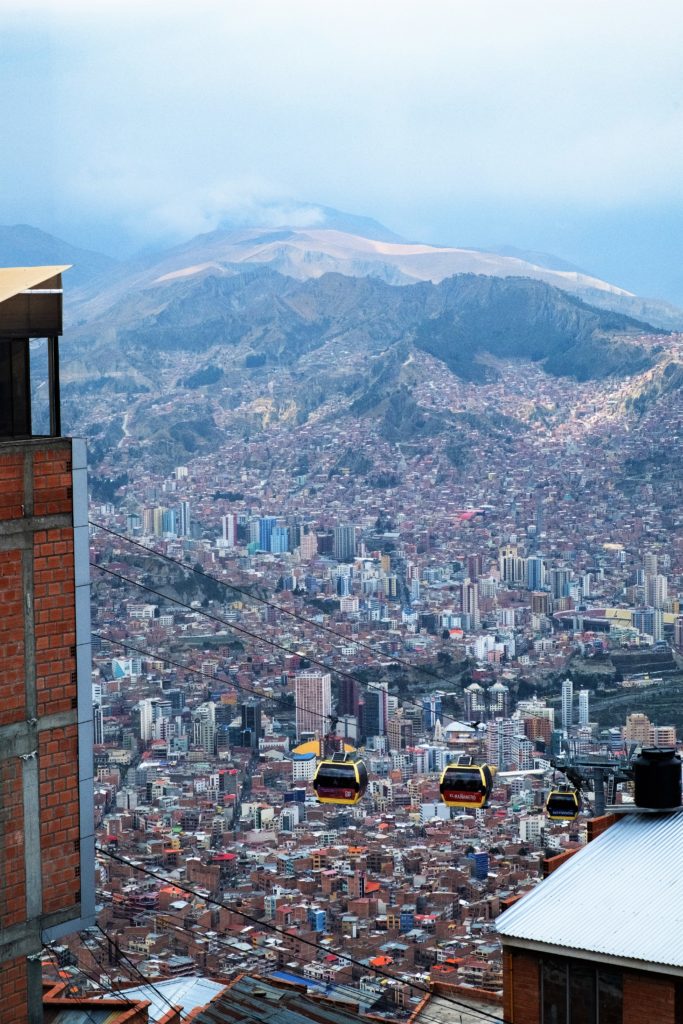Mi Teleférico – the solution of the mobility problem
Cities in South America such as Medellin, Caracas or Rio de Janeiro all have similar problems: The middle and upper classes are supplied with cars and trains and can easily reach their well-connected districts. The poorer classes, on the other hand, who often live far away in mountainous areas, have to put up with long traffic jams on their routes with buses and the local transport. To overcome the growing mobility problem, many Latin American megacities rely on cable cars.
With an altitude difference of 1,000 metres within the city, La Paz, the seat of government of Bolivia, is affected by this problem, too. Including its suburbs, the city has two and a half million inhabitants. Only six years ago, public transport consisted mainly of minibuses. But the streets are much too narrow for that, nobody came to work on time anymore, the people were annoyed by the permanent traffic jams. A solution was needed.
Mi Teleférico – the densest cable car network in the world
Where subways or metro are no options because of the steep slopes, Mi Teleférico, ‘my cable car’, provides relief. What takes at least an hour by bus, the cable car does it in 15 minutes. This helps people a lot and helps them on their daily routes.
Essentially, Mi Teleférico connects the city of El Alto with the centre of La Paz. Ten lines are already in operation, a final eleventh will be added this year. The network already extends over some 31 kilometres with a total of 28 stations, making it the densest cable car network in the world.
Mi Teleférico – the link between rich and poor
Mi Teleférico brings different worlds together. It floats above wealth as well as poverty bringing the western way of life and the indigenous culture closer together again. A trip costs about 35 Cents, which most of the inhabitants of La Paz and El Alto can afford. Besides the price and the great view, the cable car also has other advantages. They are clean and quiet, unlike the buses, which are very stuffy and quite narrow.
Unlike in other cities, the cable car in La Paz is not a complementary means of transport but is the main public transport by reaching a big part of the Bolivian population. It is the most extensive and financially costly project of the government and was built very quickly with a construction time of only six years.
Mi Teleférico – a technical masterpiece
In La Paz, the construction of the up to 65 metres high masts that support the cable car is a real challenge. They have to be placed in a way that they neither stand in the middle of the street nor do houses have to be demolished for that. Helicopters are used elsewhere to assemble the parts weighing tons, but this is not possible in Bolivias biggest city. Here most of the houses are only covered with corrugated iron and due to the strong downforce of the rotor blades, the roof would simply be uncovered. Therefore, the individual components were assembled with a crane imported from Europe, as there are no such special devices in Bolivia. Neither does a factory for masts and roll bending exists. These were pre-assembled in Austria, where Doppelmayr, the company responsible for building all the cable car lines, is based, and then simply screwed together in Bolivia.
Each of the approx. 1,400 gondolas has space for ten people. Each line can transport around 3,000 passengers per hour and direction. With a little trick, the technology can be adapted to meet the particularly high demand. The lifts then travel a little faster and the distance between the gondolas is slightly reduced. This allows the capacity to be increased to 4,000 passengers. The gondolas even offer WiFi via solar panel powered systems.
Mi Teleférico – the democratization of transport
Finding technical solutions is one thing, but the cable car must be accepted and used by the inhabitants. In the beginning, the height scared many people, but that is over now. In the meantime, Mi Teleférico has become the most popular and efficient means of transport, with over 100,000 passengers hovering over the city every day. The cable car is changing the life in La Paz permanently and has become a landmark of which the Pazeños are proud.
Cable cars are relatively fast inexpensive to build. They are environmentally friendly and, in view of the explosive population growth in cities, also allow poor inhabitants in remote areas to have access to public spaces. While cable cars in Europe and the USA are mostly used for tourism in the mountains, they represent in South America a democratization of transport.
